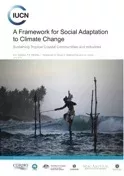 Gland, Switzerland, and Bonn, Germany, 8 June, 2010 – (IUCN) Climate change is hitting coastal areas hard: rises in sea levels, ocean acidification, extreme events, bleaching and death of coral are all climate impacts which will require adjustments socially and economically. A new IUCN report, published today, provides practical guidance for coastal communities and industries to adapt to climate change.
Gland, Switzerland, and Bonn, Germany, 8 June, 2010 – (IUCN) Climate change is hitting coastal areas hard: rises in sea levels, ocean acidification, extreme events, bleaching and death of coral are all climate impacts which will require adjustments socially and economically. A new IUCN report, published today, provides practical guidance for coastal communities and industries to adapt to climate change.
By 2015 half of the world’s population will be living within 100 km of the coast. Some 500 million people, mostly in developing countries, depend on coral reefs for food and income. However a fifth of coral reefs have disappeared and another 35 percent are under threat because of climate change. Intensive fishing, inappropriate coastal construction and pollution further increase the vulnerability to climate change of such ecosystems and of the people who depend on them. “Climate change is the biggest challenge faced by coastal communities and industries around the world,” says Carl Gustaf Lundin, Head of IUCN’s Global Marine Programme. “Setting a reliable and sustainable framework for adaptation is an urgent necessity.”
As talks under the United Nations Framework Convention for Climate Change (UNFCCC) are currently ongoing in Bonn, the IUCN report “A Framework for Social Adaptation to Climate Change: Sustaining Tropical Coastal Communities and Industries” is a guide to assess the vulnerability of coastal communities and provides economic and social tools to build resilience and avoid the worst impacts of climate change.
Adaptation to climate change is at the heart of negotiations towards a post-2012 climate deal, and building resilience of societies and ecosystems through economic diversification and the management of natural resources is considered key in this regard.
“We must increase our understanding not only of how nature responds to climate change, but of the factors that enable people and industries to cope and adapt,” says Jerker Tamelander, Oceans and Climate Change manager at IUCN and one of the authors of the report.
For example, as traditional sources of income are being depleted in the Maldives’ Baa Atoll, one of the places on earth most threatened by climate change, a coping and adaptation strategy has been put in place to provide business and marketing training to complement existing handicraft production skills. An initiative in the Bar Reef area of Sri Lanka has helped communities develop livelihoods consistent with their culture while reducing the dependence on wild capture fisheries, by helping people analyze available natural resources, local economic patterns, services available to the community and other characteristics.
By learning how people assess and manage risks, how they learn, plan and take decisions, their access to and ability to utilize networks, and what assets are at their disposal, more effective development strategies can be devised.
“People and policymakers increasingly comprehend the implications of climate change and are embracing the need for adaptation. This publication helps direct adaptation initiatives on the ground,” Tamelander adds.
Download the report at http://www.iucn.org/dbtw-wpd/edocs/2010-022.pdf
Note to editors:
The report was prepared through a working group on Climate Change and Coral Reefs, hosted by IUCN, in collaboration with Coastal Ocean Research Development Indian Ocean (CORDIO), the Commonwealth Scientific and Research Organisation (CSIRO) of Australia, the Great Barrier Reef Marine Park Authority (GBRMPA) and the Australian Research Council Centre of Excellence on Coral Reef Studies, with the support of the MacArthur Foundation and the Government of Finland.